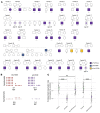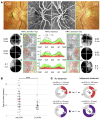Impaired complex I repair causes recessive Leber's hereditary optic neuropathy
- PMID: 33465056
- PMCID: PMC7954600
- DOI: 10.1172/JCI138267
Impaired complex I repair causes recessive Leber's hereditary optic neuropathy
Abstract
Leber's hereditary optic neuropathy (LHON) is the most frequent mitochondrial disease and was the first to be genetically defined by a point mutation in mitochondrial DNA (mtDNA). A molecular diagnosis is achieved in up to 95% of cases, the vast majority of which are accounted for by 3 mutations within mitochondrial complex I subunit-encoding genes in the mtDNA (mtLHON). Here, we resolve the enigma of LHON in the absence of pathogenic mtDNA mutations. We describe biallelic mutations in a nuclear encoded gene, DNAJC30, in 33 unsolved patients from 29 families and establish an autosomal recessive mode of inheritance for LHON (arLHON), which to date has been a prime example of a maternally inherited disorder. Remarkably, all hallmarks of mtLHON were recapitulated, including incomplete penetrance, male predominance, and significant idebenone responsivity. Moreover, by tracking protein turnover in patient-derived cell lines and a DNAJC30-knockout cellular model, we measured reduced turnover of specific complex I N-module subunits and a resultant impairment of complex I function. These results demonstrate that DNAJC30 is a chaperone protein needed for the efficient exchange of complex I subunits exposed to reactive oxygen species and integral to a mitochondrial complex I repair mechanism, thereby providing the first example to our knowledge of a disease resulting from impaired exchange of assembled respiratory chain subunits.
Keywords: Genetic diseases; Genetics; Neuroscience.
Conflict of interest statement
Figures




Comment in
-
DNAJC30 biallelic mutations extend mitochondrial complex I-deficient phenotypes to include recessive Leber's hereditary optic neuropathy.J Clin Invest. 2021 Mar 15;131(6):e147734. doi: 10.1172/JCI147734. J Clin Invest. 2021. PMID: 33720041 Free PMC article.
References
-
- Von Graefe A. Exceptionelles verrhalten des gesichtsfeldes bei pigmentenartung der netzhaut. Albrecht Von Graefes Arch Ophthalmol. 1858;4(6):250–253. - PubMed
-
- Leber TH. Ueber hereditäre und congenital-angelegte Sehnervenleiden. Albrecht Von Graefes Arch Ophthalmol. 1871;17(2):249–291. doi: 10.1007/BF01694557. - DOI
Publication types
MeSH terms
Substances
Grants and funding
LinkOut - more resources
Full Text Sources
Other Literature Sources
Medical
Molecular Biology Databases
Miscellaneous

